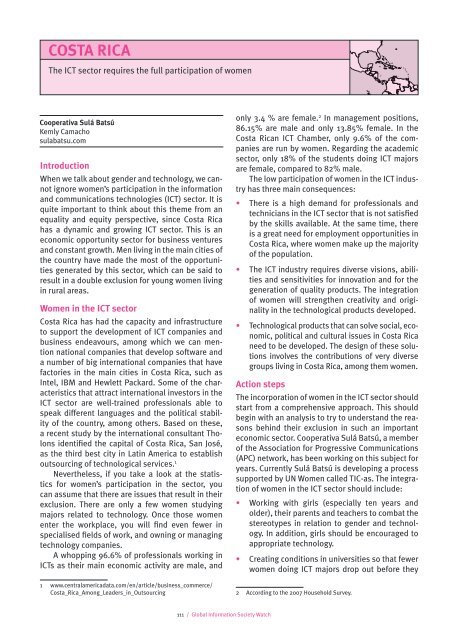gisw13_chapters
gisw13_chapters
gisw13_chapters
Create successful ePaper yourself
Turn your PDF publications into a flip-book with our unique Google optimized e-Paper software.
costa ricaThe ICT sector requires the full participation of womenCooperativa Sulá BatsúKemly Camachosulabatsu.comIntroductionWhen we talk about gender and technology, we cannotignore women’s participation in the informationand communications technologies (ICT) sector. It isquite important to think about this theme from anequality and equity perspective, since Costa Ricahas a dynamic and growing ICT sector. This is aneconomic opportunity sector for business venturesand constant growth. Men living in the main cities ofthe country have made the most of the opportunitiesgenerated by this sector, which can be said toresult in a double exclusion for young women livingin rural areas.Women in the ICT sectorCosta Rica has had the capacity and infrastructureto support the development of ICT companies andbusiness endeavours, among which we can mentionnational companies that develop software anda number of big international companies that havefactories in the main cities in Costa Rica, such asIntel, IBM and Hewlett Packard. Some of the characteristicsthat attract international investors in theICT sector are well-trained professionals able tospeak different languages and the political stabilityof the country, among others. Based on these,a recent study by the international consultant Tholonsidentified the capital of Costa Rica, San José,as the third best city in Latin America to establishoutsourcing of technological services. 1Nevertheless, if you take a look at the statisticsfor women’s participation in the sector, youcan assume that there are issues that result in theirexclusion. There are only a few women studyingmajors related to technology. Once those womenenter the workplace, you will find even fewer inspecialised fields of work, and owning or managingtechnology companies.A whopping 96.6% of professionals working inICTs as their main economic activity are male, and1 www.centralamericadata.com/en/article/business_commerce/Costa_Rica_Among_Leaders_in_Outsourcingonly 3.4 % are female. 2 In management positions,86.15% are male and only 13.85% female. In theCosta Rican ICT Chamber, only 9.6% of the companiesare run by women. Regarding the academicsector, only 18% of the students doing ICT majorsare female, compared to 82% male.The low participation of women in the ICT industryhas three main consequences:• There is a high demand for professionals andtechnicians in the ICT sector that is not satisfiedby the skills available. At the same time, thereis a great need for employment opportunities inCosta Rica, where women make up the majorityof the population.• The ICT industry requires diverse visions, abilitiesand sensitivities for innovation and for thegeneration of quality products. The integrationof women will strengthen creativity and originalityin the technological products developed.• Technological products that can solve social, economic,political and cultural issues in Costa Ricaneed to be developed. The design of these solutionsinvolves the contributions of very diversegroups living in Costa Rica, among them women.Action stepsThe incorporation of women in the ICT sector shouldstart from a comprehensive approach. This shouldbegin with an analysis to try to understand the reasonsbehind their exclusion in such an importanteconomic sector. Cooperativa Sulá Batsú, a memberof the Association for Progressive Communications(APC) network, has been working on this subject foryears. Currently Sulá Batsú is developing a processsupported by UN Women called TIC-as. The integrationof women in the ICT sector should include:• Working with girls (especially ten years andolder), their parents and teachers to combat thestereotypes in relation to gender and technology.In addition, girls should be encouraged toappropriate technology.• Creating conditions in universities so that fewerwomen doing ICT majors drop out before they2 According to the 2007 Household Survey.111 / Global Information Society Watch


